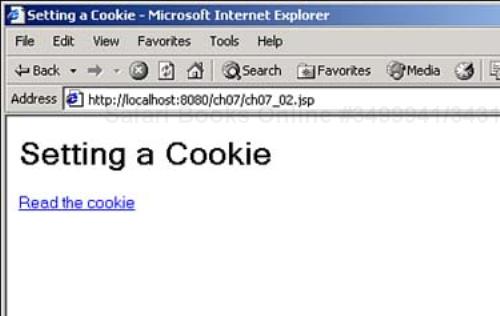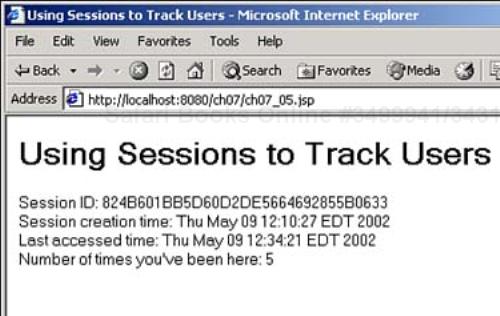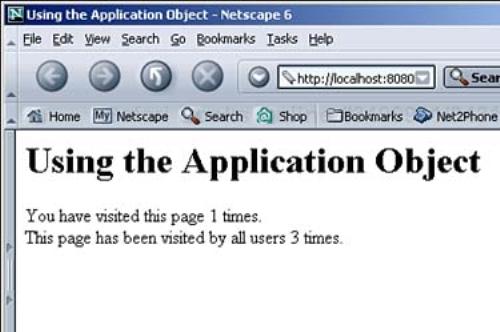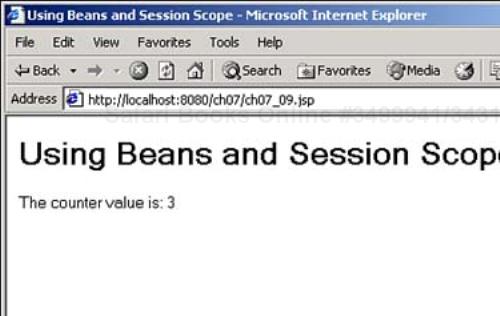Today you'll learn about one of the most popular uses of JSP—tracking users with sessions and cookies. Tracking users is a perennial problem; when a user looks at your Web page, has that user been there before? Will you be remembering something about her? Will you remember her present purchases and be checking them out, displaying their total cost? Will you be customizing her Web page in ways that she's specified in the past? Today you'll see several ways of tracking users, including the following:
Hidden text—. Using hidden controls in a Web page is the easiest way of associating some information with the user that's not directly accessible to him. However, the hidden text can be seen if the user looks at the HTML for the Web page directly.
Cookies—. This is probably the most common way of tracking users on the Internet. You can store information in a user's computer using cookies, and retrieve it when you need it. You can also specify how long the cookie should exist before being deleted by the browser.
Sessions—. Sessions are something the server offers us to support user tracking, and they're great, although they can take up a lot of resources on the server. Sessions let you preserve data between accesses to a Web page by the same user.
Applications—. Applications are much like sessions, as you'll see, but they're more general—you can share data between all the JSP pages in a site using applications. In other words, unlike sessions, applications can be used to track multiple users at the same time.
Sessions, applications, and JavaBeans—. You can also set JavaBeans so they'll be included in a session or application. Normally, the data in a JavaBean is reset each time the user accesses a page and creates an object from that bean, but you can include the bean in a session or application so its data is preserved between accesses by the same user.
The first step is to use HTML hidden controls.
Using HTML hidden controls is an easy way to store data in a Web page. For example, in this JSP page, the code will let the user set the text to store in a hidden control in a text field:
<HTML>
<HEAD>
<TITLE>Reading Hidden Controls</TITLE>
</HEAD>
<BODY>
<H1>Reading Hidden Controls</H1>
<%
String text = "";
if(request.getParameter("TEXT1") != null) {
out.println("The hidden text is:" + request.getParameter("TEXT1"));
text = request.getParameter("TEXT1");
}
%>
.
.
.
The code stores the text the user types in the hidden control, as you can see in Listing 7.1.
Example 7.1. Reading Hidden Controls (ch07_01.jsp)
<HTML> <HEAD> <TITLE>Reading Hidden Controls</TITLE> </HEAD> <BODY> <H1>Reading Hidden Controls</H1> <% String text = ""; if(request.getParameter("TEXT1") != null) { out.println("The hidden text is:" + request.getParameter("TEXT1")); text = request.getParameter("TEXT1"); } %> <FORM ACTION="ch07_01.jsp" METHOD="POST"> <INPUT TYPE="TEXT" NAME="TEXT1"> <INPUT TYPE="HIDDEN" NAME="HIDDEN" VALUE="<%= text%>"> <INPUT TYPE="SUBMIT" VALUE="Set Hidden Text"> </FORM> </BODY> </HTML>
You can see this page in Figure 7.1, where the user has entered some text and is about to click the Set Hidden Text button.
When the user clicks the button, the JSP code stores the text she's entered in a hidden control and displays that text, as you see in Figure 7.2.
The user can also take a look at the data in the hidden field directly—all she has to do is to view the HTML source of the page you see in Figure 7.2 (using the View, Source menu item in Internet Explorer, or the View, Page Source menu item in Netscape Navigator). Here's what that HTML source looks like—note the hidden control's text:
<HTML>
<HEAD>
<TITLE>Reading Hidden Controls</TITLE>
</HEAD>
<BODY>
<H1>Reading Hidden Controls</H1>
The hidden text is:Hello there!
<FORM ACTION="hidden.jsp" METHOD="POST">
<INPUT TYPE="TEXT" NAME="TEXT1">
<INPUT TYPE="HIDDEN" NAME="HIDDEN"
VALUE="Hello there!">
<INPUT TYPE="SUBMIT" VALUE="Set Hidden Text">
</FORM>
</BODY>
</HTML>
Hidden controls are fine as far as they go, but there are a number of obvious problems here—you can't store data in a secure way, and you can't store data between sessions. However, you can get around those problems with cookies.
You might not be surprised to learn that there's a class you use to work with cookies in JSP—the cookie class.
Cookies—. you either love them or hate them. They're small text strings you store on a user's computer. In the early days of cookies, people were very suspicious of them, but the truth is that they're simply text and can't cause problems (unless there are security problems in the user's browser that have not yet been exploited by hackers).
Tip
Although cookies are widely regarded as safe, many users are still wary of them, and have instructed their browsers not to accept them. If you can't set a cookie in the client browser you're working with, you might try another method of storing data, such as hidden controls. Technically, a browser is expected to support 20 cookies for each Web server; about 300 cookies total—and might limit the size of each cookie to 4KB of text.
A cookie's value can identify a user, so they are commonly used for session management. Cookies have a name and a value, and you can use methods of the Cookie class (the full name, including the Java package, is javax.servlet.http.Cookie) to get access to that data. You can also include comments in cookies and set their maximum possible ages.
Your JSP code sends cookies to the browser by using the HttpServletResponse.addCookie method. This method stores data in the HTTP response headers it sends to the browser, including the cookies you're creating.
The browser returns cookies to you by storing data in HTTP request headers. You can get cookie data using the HttpServletRequest.getCookies method, as you'll see in the upcoming examples.
You'll see how this all works in detail in today's work. You can see the methods of Cookie objects (that is, the javax.servlet.http.Cookie class) in Table 7.1.
Table 7.1. javax.servlet.http.Cookie Methods
So how do you create a cookie? You use the addCookie method of the HttpServletResponse class, and that class is coming up next.
So where does that leave you? Fortunately, the server has done all the work you'll need here—one of the built-in objects available to you in your JSP code is the response object (see “The JSP Programming Environment” in Day 2, “Handling Data and Operators”), and this is a pre-built object based on the javax.servlet.http.HttpServletResponse interface.
Just as you use the request object to see what data the user has sent to you, you can use the response object to send data back to the user. In this case, you'll use this object to send cookies back to the browser, which will store them. You can see the fields of the javax.servlet.http.HttpServletResponse interface in Table 7.2, and the methods of this interface in Table 7.3. Because the response object is built on this interface, it shares all the methods of the interface, and you'll see how to put them to work in the next topic, creating your own cookies with the addCookie method. You use the various field values in Table 7.2 if you want to send a status report back to the browser, as with the sendError or setStatus methods (which we won't do here).
Note
The convention for fields is that if its name is in capital letters, it's a read-only constant whose value doesn't change.
Table 7.2. HttpServletResponse Fields
Table 7.3. HttpServletResponse Methods
This next example will put all this new technology to work. Here, the code will create a cookie and place some text in it, and another page will read the cookie and display that text. To create the cookie, you use the Cookie class's constructor, passing it the name of the cookie (which will be message here) and the text in the cookie (which will just be “Hello!” in this case). You can also set the length of time the cookie will exist on the user's computer with the setMaxAge method, which you pass a value in seconds to—to make the cookie last for a day, you can pass a value of 24 * 60 * 60 this way:
<HTML>
<HEAD>
<TITLE>Setting a Cookie</TITLE>
</HEAD>
<BODY>
<H1>Setting a Cookie</H1>
<%
Cookie cookie1 = new Cookie("message", "Hello!");
cookie1.setMaxAge(24 * 60 * 60);
%>
.
.
.
That creates the cookie, but doesn't install it in the browser—to do that, you use the response object's addCookie method this way:
<HTML>
<HEAD>
<TITLE>Setting a Cookie</TITLE>
</HEAD>
<BODY>
<H1>Setting a Cookie</H1>
<%
Cookie cookie1 = new Cookie("message", "Hello!");
cookie1.setMaxAge(24 * 60 * 60);
response.addCookie(cookie1);
%>
.
.
.
That installs the cookie in the browser. You can also include a link to the page that will read the cookie, as you see in Listing 7.2.
You can see this page in Figure 7.3, where it's already set its cookie in the browser. The next step is to read that cookie's information back in.
To store a cookie in the user's computer, you use the request object's getCookies method. This method returns an array of Cookie objects (or null if there are no cookies) So how do you read the cookie named message? You start with the getCookies method, creating an array of Cookie objects:
<HTML>
<HEAD>
<TITLE>Reading a Cookie</TITLE>
</HEAD>
<BODY>
<H1>Reading a Cookie</H1>
<%
Cookie[] cookies = request.getCookies();
.
.
.
Tip
Are you passed all the cookies on the computer? No, you're only passed the cookies that came from the same domain as the page you're using the getCookies method in.
This returns an array of cookies, which you can loop over to find the message cookie. Here's what that loop might look like:
<HTML>
<HEAD>
<TITLE>Reading a Cookie</TITLE>
</HEAD>
<BODY>
<H1>Reading a Cookie</H1>
<%
Cookie[] cookies = request.getCookies();
for(int loopIndex = 0; loopIndex < cookies.length; loopIndex++) {
.
.
.
}
.
.
.
Inside the body of the loop, you can get the name of each cookie with the Cookie class's getName method, and its value with the getValue method. If the code finds the message cookie, it displays that cookie's value. You can see what that looks like in Listing 7.3.
Example 7.3. Reading a Cookie (ch07_03.jsp)
<HTML>
<HEAD>
<TITLE>Reading a Cookie</TITLE>
</HEAD>
<BODY>
<H1>Reading a Cookie</H1>
<%
Cookie[] cookies = request.getCookies();
for(int loopIndex = 0; loopIndex < cookies.length; loopIndex++) {
if (cookies[loopIndex].getName().equals("message")) {
out.println("The cookie says " + cookies[loopIndex].getValue());
}
}
%>
</BODY>
</HTML>
Now this page is able to read the cookie set in ch07_02.jsp. You can see what the results are in Figure 7.4, where the code was able to recover and display the cookie's text.
Now you're setting and reading cookies using JSP!
The previous example set a cookie in one page and read it in another, but sometimes you might want to set and read a cookie in the same page. For example, if your home page allows the user to customize some aspects of the page, such as its background color, you can store that information in a cookie. The next time the user opens your home page, your code can read that cookie and display the correct background color.
Here's an example to show how this works—in this case, the code will set a cookie named color to cyan, and the next time you load the same page, the JSP code will use that cookie to change the background color of the page to cyan. When the page loads, it will check for the cookie named color, and if it's found, use its value to set the background color of the Web page. However, if that cookie isn't found, the code will set a Boolean variable named foundCookie to false, which means it will have to create the cookie:
<HTML>
<HEAD>
<TITLE>Setting and Reading Cookies</TITLE>
</HEAD>
<BODY
<%
Cookie[] cookies = request.getCookies();
boolean foundCookie = false;
for(int loopIndex = 0; loopIndex < cookies.length; loopIndex++) {
Cookie cookie1 = cookies[loopIndex];
if (cookie1.getName().equals("color")) {
out.println("bgcolor = " + cookie1.getValue());
foundCookie = true;
}
}
.
.
.
If foundCookie is false the code will set the color cookie. You can test if foundCookie is false with an if statement and the JSP not operator. ! (discussed in Day 2), which flips the Boolean sense of its argument like this
if(!foundCookie)
where the body of the if statement is executed if the color cookie wasn't found. In that case, the code creates the cookie and stores it as you see in Listing 7.4.
Example 7.4. Setting and Reading Cookies in the Same Page (ch07_04.jsp)
<HTML> <HEAD> <TITLE>Setting and Reading Cookies</TITLE> </HEAD> <BODY <% Cookie[] cookies = request.getCookies(); boolean foundCookie = false; for(int loopIndex = 0; loopIndex < cookies.length; loopIndex++) { Cookie cookie1 = cookies[loopIndex]; if (cookie1.getName().equals("color")) { out.println("bgcolor = " + cookie1.getValue()); foundCookie = true; } } if (!foundCookie) { Cookie cookie1 = new Cookie("color", "cyan"); cookie1.setMaxAge(24*60*60); response.addCookie(cookie1); } %> > <H1>Setting and Reading Cookies</H1> This page will set its background color using a cookie. </BODY> </HTML>
When you load this page the first time, it sets the color cookie, and the page background will be white. When you load the page from then on, until the cookie expires, the page reads that cookie and uses it to turn the page background cyan, as you see in Figure 7.5.
That gives you a good foundation on how to use cookies. You've seen how to set cookies and read them back in, using separate pages or the same page. You've seen how to specify how long the cookie should exist, what its name should be, and what its value should be. As you can see, cookies are great for tracking individual users—after all, you're storing data on the user's computer; how much more tracking do you need?
It turns out that you might indeed need more tracking—you might want to preserve the data in various variables in your code between user accesses to the page. Cookies can store data as text on the user's computer for you, but what if you want to store your data in objects—and have those objects retain their value between page loadings? For something such as that, you can use sessions.
This is very different from writing a standard program, where you're interacting with the user while the program is running, so you can store data in variables and count on it not being reset to its default values the next time you look at that data. Using sessions, you actually can do the same thing in JSP—you can interact with the user as though you have a session going.
What does that mean? During the time a session is active, you can store data in the session, and it'll be preserved on the server in between times the user accesses your page. You can set your variables in one page access, and they'll hold the same data the next time you see the page, as long as the session hasn't timed out (see “Setting Session Timeouts” later today). The default time Tomcat allows between page accesses in a session is 30 minutes.
Note
You should realize that it might not be possible for Tomcat to set up a session with the browser. Tomcat usually uses cookies to store session information, but the browser may have cookies turned off, for example (in that case, Tomcat tries to encode the needed information in URLs, but sometimes that is not successful). If Tomcat is not able to create a session with the browser, the isNew method will keep returning true every time the page is accessed, and the session ID will be different for each page access. You can also use the isRequestedSessionIdFromURL and isRequestedSessionIdFromCookie methods to see how Tomcat is storing session information—see Table 4.2.
Those are just a few of the methods of the javax.servlet.http.HttpSession interface—you can see them in Table 7.4.
Table 7.4. javax.servlet.http.HttpSession Methods
Method | Does This |
|---|---|
| Adds the specified cookie to the response object. |
| Returns the object of the given name in this session. |
| Returns a Java |
| Returns the time when this session was created (measured in milliseconds since midnight January 1, 1970 GMT). |
| Returns a string containing the identifier for this session. |
| Returns the last time the client sent a request in with this session, as the number of milliseconds since midnight January 1, 1970 GMT. |
| Returns the maximum time, in seconds, which the server will keep this session open between client accesses. |
| |
| As of servlet specification version 2.1, this method is deprecated. |
| Deprecated. As of servlet specification version 2.2, this method is replaced by |
| Deprecated. As of servlet specification version 2.2, this method is replaced by |
| Invalidates this session. |
| Returns |
| Deprecated. As of servlet specification version 2.2, this method is replaced by |
| Removes the object with the specified name from this session. |
| As of servlet specification version 2.2, this method is replaced by |
| |
| Specifies the time, in seconds, between client requests before the server will invalidate this session. |
This is all best seen in an example. This next example will show how to store the number of times the user has accessed the page in the current session, as well as how to get the session ID, when the session was created, and the last time the page was accessed in the current session. This example starts with the page directive first discussed in Day 1, “Getting Started!,” with the directive's session attribute set to true:
<%@page import = "java.util.*" session="true"%>
This makes sure that opening this page starts a new session if such a session doesn't already exist. Technically speaking, this page directive is not necessary, because the default for the session attribute is true, but it's included here just for completeness (you can omit it in your own session-based code).
This example will keep track of the number of times the user has viewed the current page in a session attribute named counter. The first thing to do is see if this attribute has already been set in a former page access in this session, which you can do with the getAttribute method.
Here's something to note—you can't store the basic data types such as int in session attributes—you can only store Java objects, which are based on the java.lang.Object class (all Java objects are based on the same class). String objects are fine to store as attributes—but what about integer values such as our counter value? Java has a class to match all the basic data types—Integer for int values, Double for double values, and so on. You can create an object using these classes by passing a string (like 3) to the class's constructor, or by passing a value of the corresponding data type to the class's constructor (for example: Integer integerObject = new Integer(3) or Double doubleObject = new Double(3.14)). You can recover the data in the corresponding basic data form with the intValue method of the Integer class, doubleValue method of the Double class, and so on.
The counter variable will be stored as an Integer object, so here's how you can read its value from the session object using the getAttribute method:
<%@page import = "java.util.*" session="true"%>
<HTML>
<HEAD>
<TITLE>Using Sessions</TITLE>
</HEAD>
<BODY>
<%
Integer counter =
(Integer)session.getAttribute("counter");
.
.
.
If counter has not been set before, getAttribute will return a value of null. That means you can create the counter value, or increment it if it already exists, and store the new value in the session object like the following:
<%@page import = "java.util.*" session="true"%>
<HTML>
<HEAD>
<TITLE>Using Sessions</TITLE>
</HEAD>
<BODY>
<%
Integer counter =
(Integer)session.getAttribute("counter");
if (counter == null) {
counter = new Integer(1);
} else {
counter = new Integer(counter.intValue() + 1);
}
session.setAttribute("counter", counter);
.
.
.
That way you can store and retrieve data in the session object. You can also get the current session ID with the getID method. You get the time the session was created with the getCreationTime method, and you get the time the session was last accessed with the getLastAccessedTime method. You can see all this at work in Listing 7.5.
Example 7.5. Creating and Using a Session (ch07_05.jsp)
<%@page import = "java.util.*" session="true"%>
<HTML>
<HEAD>
<TITLE>Using Sessions to Track Users</TITLE>
</HEAD>
<BODY>
<%
Integer counter =
(Integer)session.getAttribute("counter");
if (counter == null) {
counter = new Integer(1);
} else {
counter = new Integer(counter.intValue() + 1);
}
session.setAttribute("counter", counter);
%>
<H1>Using Sessions to Track Users</H1>
Session ID: <%=session.getId()%>
<BR>
Session creation time: <%=new Date(session.getCreationTime())%>
<BR>
Last accessed time: <%=new Date(session.getLastAccessedTime())%>
<BR>
Number of times you've been here: <%=counter%>
</BODY>
</HTML>
You can see the results in Figure 7.6, where the user has opened this page and reloaded it a number of times.
Using sessions such as this is great for storing and recovering data—it provides you with an environment much like a standard program, where you interact with the user without having to worry about having your data reset.
You can use methods of the session object to set the maximum time between page accesses before the server ends the session:
If you set the lifetime of a session to -1, the session will never expire.
The default timeout between user accesses for sessions in Tomcat is 30 minutes. You can change this in Tomcat's web.xml file (stored as jakarta-tomcat-4.0.3confweb.xml). All you have to do is change the time stored in the <session-timeout> element:
<!-- ==================== Default Session Configuration ================= --> <!-- You can set the default session timeout (in minutes) for all newly --> <!-- created sessions by modifying the value below. --> <session-config> <session-timeout>30</session-timeout> </session-config>
A session enables you to track one user at a time—an application enables you to track all JSPs in the same site, no matter how many users are using them. To access the current application, you can use the built-in JSP application object. Like the session object, the application object is based on the javax.servlet.http.HttpSession interface. In the previous example, you saw how to create a session attribute named counter, which stores the number of times the user has visited the page in the current session. In the same way, you can create an application attribute named applicationCounter that holds the total number of times anyone in the same application has viewed a JSP page:
Integer applicationCounter = (Integer)application.getAttribute("applicationCounter");
if (applicationCounter == null) {
applicationCounter = new Integer(1);
} else {
applicationCounter = new Integer(applicationCounter.intValue() + 1);
}
application.setAttribute("applicationCounter", applicationCounter);
You can see this at work in Listing 7.6, where the code supports a counter for the number of visits in the current session, and in the current application.
Example 7.6. Using the Application Object (ch07_06.jsp)
<HTML>
<HEAD>
<TITLE>Using the Application Object</TITLE>
</HEAD>
<BODY>
<H1>Using the Application Object</H1>
<%
Integer counter = (Integer)session.getAttribute("counter");
String heading = null;
if (counter == null) {
counter = new Integer(1);
} else {
counter = new Integer(counter.intValue() + 1);
}
session.setAttribute("counter", counter);
Integer applicationCounter = (Integer)application.getAttribute("applicationCounter");
if (applicationCounter == null) {
applicationCounter = new Integer(1);
} else {
applicationCounter = new Integer(applicationCounter.intValue() + 1);
}
application.setAttribute("applicationCounter", applicationCounter);
%>
You have visited this page <%=counter%> times.
<BR>
This page has been visited by all users <%=applicationCounter%> times.
</BODY>
</HTML>
In this example, the session counter keeps track of the number of times a user has visited the page, and the application counter keeps track of the number of times all users have accessed the page. This isn't particularly easy to see on the same computer, because Tomcat will count you as the same user. However, you can get around that if you happen to have different browsers. For example, you can open it in Internet Explorer and reload a few times, as you see in Figure 7.7. If you then open it in another browser, such as Netscape Navigator, you'll see that the application counter is indeed keeping track of users across sessions, as shown in Figure 7.8.
The bean you see in Listing 7.7 maintains a property named counter that JSP code can increment—we'll see that using page scope, counter is reset to 1 each time the page loads, but using session scope, counter will increment to 2, 3, 4, and so on as you reload the page, because the bean is stored in the session's data.
You can see a JSP page that uses this bean with page scope in Listing 7.8.
Example 7.8. Using Page Scope for Beans (ch07_08.jsp)
<HTML>
<HEAD>
<TITLE>Using Beans and Page Scope</TITLE>
</HEAD>
<BODY>
<H1>Using Beans and Page Scope</H1>
<jsp:useBean id="bean1" class="beans.ch07_07" scope="page" />
<%
bean1.setCounter(bean1.getCounter() + 1);
%>
The counter value is: <jsp:getProperty name="bean1" property="counter" />
</BODY>
</HTML>
And you can see that Web page at work in Figure 7.9—no matter how many times you reload this page, the counter will remain set to 1, because the bean has page scope, so it's created anew each time you load the page.
However, if you give the bean session scope, as in Listing 7.9, it's stored with the rest of the session, which means the counter value will be preserved between page accesses.
Example 7.9. Using Session Scope for Beans (ch07_09.jsp)
<HTML> <HEAD> <TITLE>Using Beans and Session Scope</TITLE> </HEAD> <BODY> <H1>Using Beans and Session Scope</H1> <jsp:useBean id="bean1" class="beans.ch07_07" scope="session" /> <% bean1.setCounter(bean1.getCounter() + 1); %> The counter value is: <jsp:getProperty name="bean1" property="counter" /> </BODY> </HTML>
You can see the results of giving the bean session scope in Figure 7.10.
Today you learned how to track users with cookies and sessions in JSP. Everything started by using HTML hidden controls to store data in the Web page sent to the browser and then sent back to the server. Although storing data in hidden controls works, it's not very secure, and the data stored in those controls is visible if the user views the page's HTML source.
You learned that you can use cookies to store text data on a person's computer, using Cookie objects and the response object's addCookie method. You can retrieve those objects with the request object's getCookies method.
To support a session, you use the session object. As you've seen, you can get the session's ID, creation time, last accessed time, and more using session methods. Sessions let you establish a workable connection with the user's browser, letting you store data between page accesses.
You can also use application objects to store data; an application is broader than a session, because sessions deal with a single user, but an application includes all the users using JSP pages on your site.
Finally, you learned that you can store beans in sessions and applications if you set the scope attribute <jsp:useBean> to the appropriate values.
This workshop tests whether you understand all the concepts you learned today. It's a good idea to master today's concepts by honing your knowledge here before starting tomorrow's material. You can find the answers to the quiz questions in Appendix A.
1: | Create a sample home page that accepts a person's name and birthday using text fields (use text fields for the name, birth month, and birth day) and stores that information using a cookie that lasts a year. Then use the |
2: | Try repeating the JavaBean example in the topic “Using Sessions, Applications, and JavaBeans,” but this time, give the bean application scope to create a Web page counter that uses the counter in the bean to indicate the total number of times the page has been accessed by anyone, and then test it out. Also, use the |










